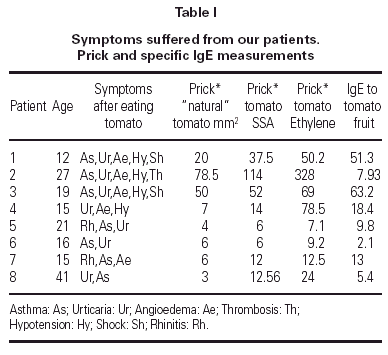The tomato (Lycopersicon esculentum) is a member of the Solanaceae family. The prevalence of tomato allergy was estimated to range from 1.5 to 16 % among food-allergic populations and reached up 39.2 % among grass pollen allergics1. Although tomato has been widely investigated for breeding purposes, there have been no studies on tomato allergenicity after different treatments. Tomato proteins binding to IgE from patient suffering from oral allergy syndrome have been identified as polygalacturonase, β-fructofuranosidase, superoxide dismutase and pectinesterase and their concentrations was highest in the red ripening stage with both SDS-PAGE and immunoblotting. Nevertheless, few immunologic studies in patients with anaphylaxis after ingestion of tomato have been performed2. Plant hormones like ethylene and salicylic acid (SAA) are widely studied as signal molecules which induce production of defense-related proteins and their activity has been studied in different plants models3.
We attempted to evaluate the effects of plant hormone treatment on the allergenic capacity of tomato analyzing three different samples: fruits grown under biological conditions without addition of chemical products, and treated with ethylene (Ethephon, Sigma) or with SAA (Bayer) in order to compare the IgE-binding protein response.
MATERIAL AND METHODS
Prick by prick tests were carried out with the three different tomato samples grown in a same area in eight patients with ages between 12 and 27 years who suffered from anaphylaxis episodes after eating raw tomatoes (table I). Six of them also presented sensitization to grass pollen and 4 to nuts. The same tests were performed in 15 control patients, obtaining negative responses in all cases. The range of specific IgE levels to tomato (CAP-FEIA, Pharmacia, Sweden) was between 7.93 and 63.2 kU/L.
An immunoblot experiment with the three different tomato extracts was performed using sera from these eight patients and controls and following the methods previously described5. Briefly, PBS extracts from untreated and ethylene and SAA-treated tomato fruits were separated by SDS-PAGE, electrotransferred onto PVDF membranes and immunoblotted with a serum pool from the tomato allergic patients or with monospecific polyclonal antobodies to plant chitinases.
RESULTS
The wheals obtained in prick tests were significantly higher with the extracts of tomato treated with ethylene and SAA (χ2 = 31.3, p < 0.0001) and the patients who presented higher wheal diameters in skin tests were those who had more severe episodes of anaphylaxis (table I). Protein bands with apparent molecular sizes from 5 to 70 kDa were found in the PBS extract, as well as 3-4 IgE-binding bands from 34 to 50 kDa. Neither the protein stain nor the IgE immunodetection patterns clearly varied between the untreated and the hormone-treated samples. A component above 45 kDa was recognized in all three extracts by the anti-chitinases antibodies showing a similar intensity in the three cases.
CONCLUSIONS
In summary, practical applications to enhance the productivity of agriculture by using plants with improved resistance to pathogens are expected to increase in the near future. Defense proteins play an important role in pathogen resistance, and some defense-related proteins are significant cross-reacting allergens. In the case of anaphylaxis induced by tomato, the treatment with plant hormones induced a higher cutaneous response than with non-manipulated tomato, but the "in vitro" response was similar. Clinical relevance of changes in allergenicity after tomato ripening manipulation deserves further analysis.






